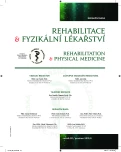-
Medical journals
- Career
The Assessment of Muscle Activation with the Use of Surface Electromyography in Patients with Parkinson’s disease during a Unipedal Standing Test
Authors: Zaatar A. M. Z.; J. Opavský
Authors‘ workplace: Katedra fyzioterapie, Fakulta tělesné kultury, Univerzita Palackého v Olomouci vedoucí katedry prof. MUDr. J. Opavský, CSc.
Published in: Rehabil. fyz. Lék., 20, 2013, No. 4, pp. 189-195.
Category: Original Papers
Overview
The main signs of Parkinson’s disease include balance disorders, which are associated with a high risk of fall and injuries. The order and muscle activation patterns in these patients in postural-demanding conditions have not been sufficiently clarified yet. We therefore investigated the muscle activation patterns during the transition from bipedal to unipedal stance in a group of patients with Parkinson’s disease and in a control group using surface electromyography (sEMG). Our objective was to determine, whether the activation order differs between the two groups and whether the findings depend on the degree of elevation of the lifted extremity. The secondary objective was to determine, whether sEMG findings on the preferred (dominant) and non-preferred extremity differ. The observed differences between the two groups included muscle activation patterns as well as changes related to the extent of elevation of the lifted leg and differences between the muscle activation order on the preferred (dominant) and non-preferred leg.
Keywords:
Parkinson´s disease, surface electromyography, muscle activation, unipedal standing test, dominant leg, preferred leg
Sources
1. Błaszczyk, J. W., Lowe, D. L., Hansen, P. D.: Ranges of postural stability and their changes in the elderly. Gait & Posture, 2, 1994, 1, s. 11-17.
2. Cioni, M., Richards, C. L., Malouin, F., Bedard, P. J., Lemieux, R.: Characteristics of the electromyographic patterns of lower limb muscles during gait in patients with Parkinson´s disease when OFF and ON L-Dopa treatment. Ital. J. Neurol. Sci,, 18, 1997, 4, s. 195-208.
3. Dietz, V., Zijlstra, W., Prokop, T., Berger, W.: Leg muscle activation during gait in Parkinson´s disease: adaptation and interlimb coordination. Electroencephalogr Clin. Neurophysiol., 97, 1995, 6, s. 408-415.
4. Hof, A. L., Elzinga, H., Grimmius, W., Halbertsma, J. P. K.: Speed dependency of averaged EMG profiles in walking. Gait and Posture, 16, 2002, 1, s. 78-86.
5. Hoffman, M., Schrader, J., Applegate, T., Koceja, D.: Unilateral postural control of the functionally dominant and nondominant extremities of healthy subjects. J. Athl. Train, 33, 1998, 4, s. 319-322.
6. Kolář, P.: Vertebrogenní obtíže a stabilizační funkce svalů – diagnostika. Rehabil. fyz. Lék., 13, 2006, 4, s. 155-170.
7. Konczak, J., Corcos, D. M., Horak, F., Poizner, H., Shapiro, M., Tuite, P., Volkmann, J., Maschke, M.: Proprioception and motor control in Parkinson´s disease. J. Mot. Behav., 41, 2009, 6, s. 543-552.
8. Lu, W.W., Hu, Y., Luk, K. D. , Cheung, K. M., Leong, J. C.: Paraspinal muscle activities of patients with scoliosis after spine fusion: An electromyographic study. Spine, 27, 2002, 11, s. 1180-1185.
9. McCurdy, K., Langford, G.: The relationship between maximum unilateral squat strength and balance in young adult men and women. J. Sports Sci. Med., 5, 2006, 2, s. 282-288.
10. Wai-Hang, J. L.: Are you left-handed? Footedness questionnaire. 2004. Dostupné 16. 3. 2004 na: http://jackie.freeshell.org/woh/test_foot.htm.
11. Winter, D. A.: Human balance and posture control during standing and walking. Gait and Posture, 3, 1995, 4, s. 193-214.
12. WUSTENEY, E., JOY, K.: The use of the neurologic rehabilitation model in the assessment and treatment of patients with balance. In: Mills, V. M., Cassidy, W., Katz, D. I. (eds.): Neurologic Rehabilitation: A Guide to Diagnosis, Prognosis, and Treatment Planning. Massachusetts: Blackwell Science, 1997, s. 237-281.
Labels
Physiotherapist, university degree Rehabilitation Sports medicine
Article was published inRehabilitation & Physical Medicine

2013 Issue 4-
All articles in this issue
- Trunk and Cervica Muscles Activity during Straightening of Cervicothoracic Spine Segment Provoked by External Rotation of the Arm
- Combined Training of Closed and Open Kinematic Chains in Rehabilitation Exemplified by the FLOWIN® System
- Osteochondral Articular Junction and Osteoarthrosis
- The Assessment of Muscle Activation with the Use of Surface Electromyography in Patients with Parkinson’s disease during a Unipedal Standing Test
- The Observation of the Dynamics of a Clinical Picture in a Chronic Cervicobrachial Syndrome with the Aid of the Principles of McKenzie Concept
- Evaluating the Quality of Life of Patients with Spinal Cord Injury
- The Inclination and Shape Modulation of Cervicothoracic Connection of Spine Provoked by External Rotation of the Arm
- Rehabilitation & Physical Medicine
- Journal archive
- Current issue
- Online only
- About the journal
Most read in this issue- Combined Training of Closed and Open Kinematic Chains in Rehabilitation Exemplified by the FLOWIN® System
- Osteochondral Articular Junction and Osteoarthrosis
- The Observation of the Dynamics of a Clinical Picture in a Chronic Cervicobrachial Syndrome with the Aid of the Principles of McKenzie Concept
- The Inclination and Shape Modulation of Cervicothoracic Connection of Spine Provoked by External Rotation of the Arm
Login#ADS_BOTTOM_SCRIPTS#Forgotten passwordEnter the email address that you registered with. We will send you instructions on how to set a new password.
- Career

